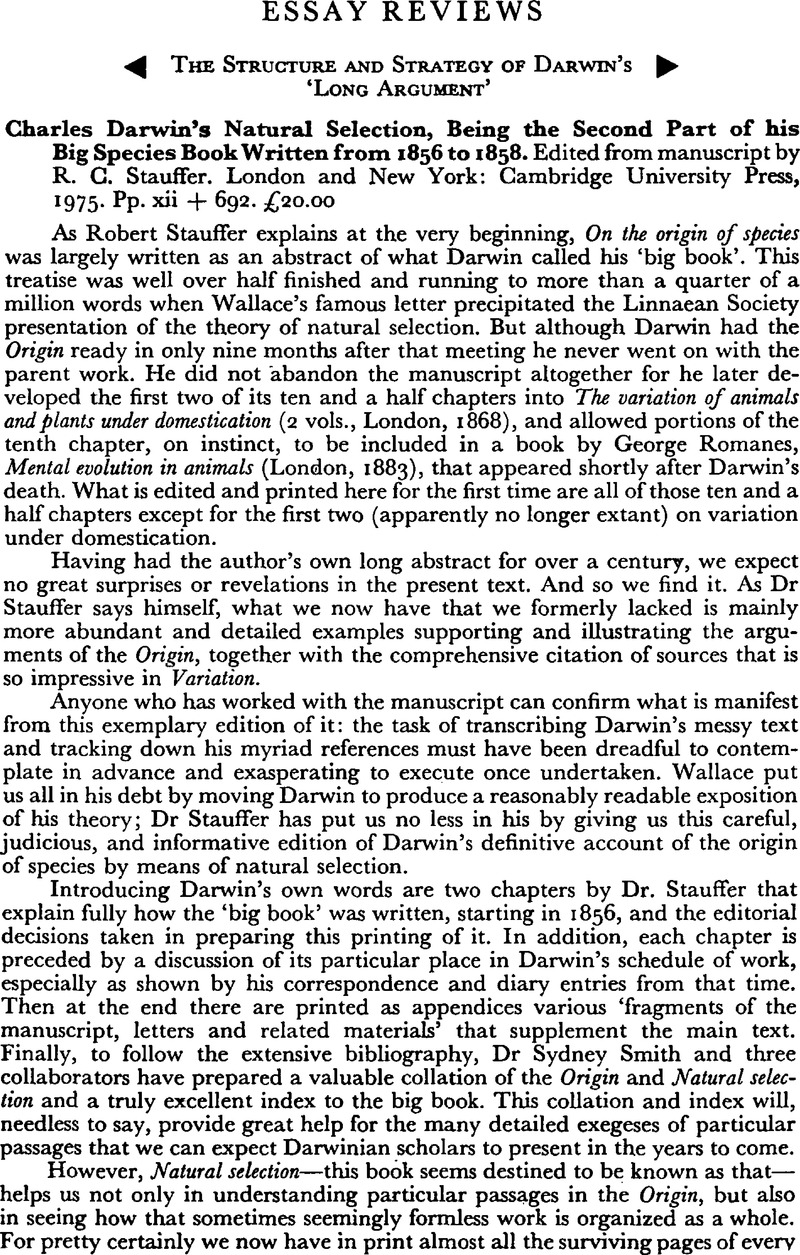Article contents
The Structure and Strategy of Darwin's ‘Long Argument’
Published online by Cambridge University Press: 05 January 2009
Abstract

- Type
- Essay Reviews
- Information
- The British Journal for the History of Science , Volume 10 , Issue 3 , November 1977 , pp. 237 - 246
- Copyright
- Copyright © British Society for the History of Science 1977
References
1 For the first of these, see Vorzimmer, P. J., ‘An early Darwin manuscript: the “Outline and draft of 1839”’, Journal of the history of biology viii (1975), 191–217Google Scholar. Vorzimmer discusses in detail the dating of the outline and of the draft, admitting that while some evidence favours 1839, the two documents may be of different dates and both later than 1839. The thirteen-page draft deals only with domestic variation. The outline, published earlier by Francis Darwin in his introduction to the Sketch and Origin, identifies the three parts of a projected work on the origin of species by natural selection, as I have explained later in this review. Apart from Stauffer's edition of Natural selection, I refer here to the edition of the Sketch and of the Essay in Darwin, C. and Wallace, A. R., Evolution by natural selection (Cambridge, 1958. Reprinted, New York and London, 1971)Google Scholar which includes Francis Darwin's 1909 introduction to those writings, and to the facsimile of the first (1859) edition of the Origin of species (Cambridge, Mass., 1964).Google Scholar
2 Kavaloski, V. C., The vera causa principle: a historico-philosophical study of a melatheoretical concept from Newton through Darwin. Ph.D. dissertation. University of Chicago, 1974.Google Scholar
3 Koyré, A., ‘Newton's “Regulae philosophandi”’, in Koyré, , Newtonian studies (Cambridge, Mass., 1965), pp. 261–72.CrossRefGoogle Scholar
4 Text and translation in Koyré, , op. cit., p. 265Google Scholar. For a fuller citation of the texts in Newton's three editions, see Koyré, A. and Cohen, I. B. (eds.), Isaac Newton's Philosophiae naturalis principia mathematica. The third edition with variant readings (Cambridge, 1972), ii, 550.Google Scholar
5 Reid, Thomas, Essays on the intellectual powers of man (Edinburgh, 1785) as quoted in Kavaloski, op. cit., p. 6.Google Scholar
6 Herschel, J. F. W., Preliminary discourse on the study of natural philosophy (London. 1830), p. 148.Google Scholar
7 Darwin, F. (ed.), The life and letters of Charles Darwin (3 vols., London, 1888) iii. 24–5.Google Scholar
8 Darwin, , Sketch in Evolution by natural selection, pp. 57–8.Google Scholar
9 Ibid., p.59
10 As in Darwin, F., ‘Introduction’, op. cit., p. 29Google Scholar. Cf. Vorzimmer's discussion of this text in his article cited in note 1.
11 Sketch, loc. cit., p. 46Google Scholar. Cf. Darwin, F., ‘Introduction’, pp. 29–30.Google Scholar
12 Variation of animals and plants under domestication (2 vols., New York, 1868), i. 13, 15 and 21.Google Scholar
13 For this division of the Principles into four books—not explicit in the first edition—see the table of contents in Principles of geology (5th edn., 4 vols., London, 1837).Google Scholar
- 65
- Cited by




